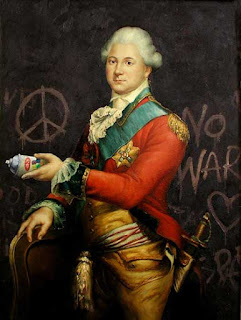NEW YORK (Reuters) - Many a visitor to New York's Museum of Modern Art has probably thought, "I could do that."Banksy's Website: http://www.banksy.co.uk
A British graffiti artist who goes by the name "Banksy" went one step further, by smuggling in his own picture of a soup can and hanging it on a wall, where it stayed for more than three days earlier this month before anybody noticed.
The prank was part of a coordinated plan to infiltrate four of New York's top museums on a single day.
The largest piece, which he smuggled into the Brooklyn Museum, was a 2 foot by 1.5 foot (61cm by 46 cm) oil painting of a colonial-era admiral, to which the artist had added a can of spray paint in his hand and anti-war graffiti in the background.
The other two targets were the Metropolitan Museum of Art and the American Museum of Natural History, where he hung a glass-encased beetle with fighter jet wings and missiles attached to its body -- another comment on war, Banksy told Reuters on Thursday.
"It was just an outsider's view of the modern American bug, bristling with listening devices and military hardware," he said.
An art Web site called www.woostercollective.com has posted pictures of the artist -- wearing an Inspector Clouseau-style overcoat, a hat and a fake beard and nose -- hanging up his work at the four museums and describing how he did it.
Speaking by telephone from an undisclosed location in Britain, Banksy said he conducted all four operations on March 13, helped by accomplices who filmed him and provided distractions where necessary.
"They staged a gay tiff (lovers' quarrel), shouting very loudly and obnoxiously," said the artist, declining to give his real name or any personal details beyond his occupation as a professional painter and decorator.
It is not the first time he has staged such stunts. Last year he smuggled work into the Louvre in Paris and London's Tate, attracting attention in the British media.
"My sister inspired me to do it. She was throwing away loads of my pictures one day and I asked her why. She said 'It's not like they're going to be hanging in the Louvre.'"
He took that as a challenge. "I thought why wait until I'm dead," he said.
His preferred creative outlet, graffiti on trains, was growing more difficult due to greater security so he decided to branch out into infiltrating museums. "I tend to gravitate to places with less sophisticated security systems," he said.
Officials at the Natural History Museum declined to comment on security. Museum of Modern Art officials said only that the offending picture was taken down on March 17.
It was unclear what gave the game away but Banksy's version of Andy Warhol's iconic images of Campbell's Soup Cans showed a can of Tesco value tomato soup, a discounted brand sold by a British supermarket chain.
"Obviously they've got their eye a lot more on things leaving than things going in which works in my favor," Banksy said. "I imagine they'll be doing stricter bag checks now."
He said the painting in the Metropolitan Museum, a small portrait of a woman wearing a gas mask, had been discovered after one day, while the others stayed up for several days. The paintings were fixed to the wall with extra-strong glue.
Asked how he managed to escape notice while putting them up on a busy Sunday at the museums, he said: "They do get pretty full, but not if you put the pictures in the boring bits."
Wooster Collective: http://www.woostercollective.com ( With commentary and other exclusive information, including images of Banksy placing his pieces up in the museums)















